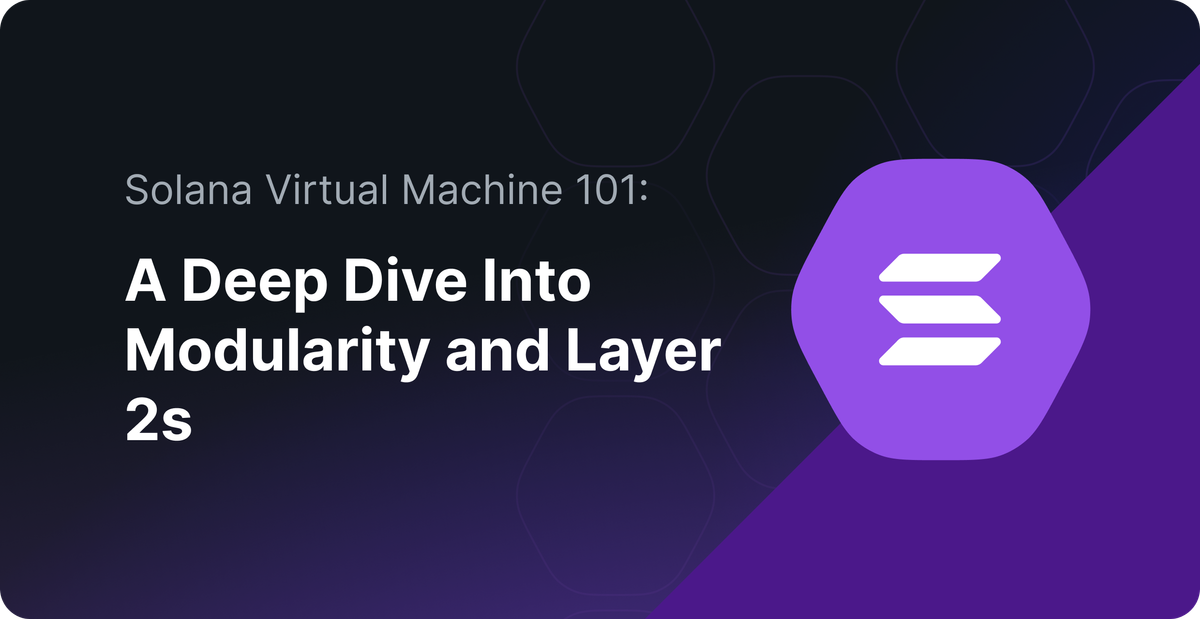Solana Virtual Machine (SVM) 101 — A Deep Dive Into Modularity and Layer 2s
Discover how the Solana Virtual Machine (SVM) empowers Solana’s scalability and supports a thriving DeFi ecosystem with high throughput and efficient off-chain processing.

Solana is seeing a continuous uptick in onchain activity, driven especially by DeFi (decentralized finance) apps.
This growth means a huge influx of users, money, and developer interest in Solana. When you pair this growing interest with the blockchain’s infrastructural superpowers like fast finality, high throughput, and affordable gas costs, it truly unlocks the blockchain’s potential.
As onchain activity and volume grow on Solana, the need for scalability will hit the network soon. This is where its execution engine — the Solana virtual machine (SVM) takes the driver's seat. SVM helps in scaling the blockchain by allowing for parallel processing and also in the building of layer 2 solutions.
This blog explains the SVM in-depth and also dives into the future of Solana w.r.t. scalability, layer 2 solutions, and the birth of Solana’s modularity thesis.
SVM: The Execution Environment On Solana
Solana Virtual Machine (SVM) is an execution environment that processes smart contract transactions on the Solana blockchain.
Like other blockchain virtual machines, SVM is software that executes smart contract transactions and handles the changes in the blockchain state after the transaction.
Uniquely, SVM is designed for parallel processing, allowing Solana to process multiple non-conflicting transactions simultaneously. This design mechanism is based on Solana’s runtime environment called Sealevel which trumps the traditional VMs in terms of overall throughput and speed.
This way, the SVM offers several distinct benefits:
- High throughput with a block time of just 400 milliseconds, thanks to parallel processing of transactions.
- Efficiency and scalability improvement because of Solana's separation of code (smart contracts) from state (accounts).
- Economies of scale can be achieved with the high throughput being processed very efficiently.
Now that we understand the ABCs of Solana VM, let’s see how it fares against the EVM — Ethereum Virtual Machine.
SVM vs EVM: What Are the Differences?
The key difference between the Ethereum Virtual Machine (EVM) and the Solana Virtual Machine (SVM) lies in their approach to transaction processing.
However, there are a few more key differences in how both virtual machines work. Here’s a table to understand better:

This table crystallizes the key differences between SVM and EVM.
Simply put, each difference is based on the architectural divergence of parallel vs sequential processing. However, this results in SVM offering superior scalability and lower transaction fees, making it a more performant environment for high-throughput blockchain applications.
The tradeoff is, however, the broader ecosystem compatibility that EVM currently enjoys.
An already high-performant SVM is now going to be more accessible to developers with a new upgrade, leading to off-chain processing and layer 2s. The next section is dedicated to this update.
SVM Decoupling and Solana Modularity
Anza, Solana’s developer shop, in June 2024, introduced the SVM API which separates the SVM from the Solana validator. This means that the SVM can now function independently from the blockchain's core infrastructure, the validator, and can be used for off-chain purposes.
The decoupling also gave rise to SVM Test Harness — a standalone API that simulates the transaction processing environment of Solana off-chain.
The API offers a streamlined interface for developers to work with core Solana components, such as a transaction processor, account database, and program cache, allowing developers to work more efficiently without needing to engage with the full Solana runtime.
Now, what does this mean?
Offchain development
Developers can now create dApps that don’t need a Solana validator to process the transactions. They can interact with Solana’s infrastructure in off-chain services, state channels, subnets, or rollups and only settle the final state on-chain. This means more dApps and solutions can be built without increasing the load on the network.
As a result, Solana’s network becomes more scalable and can support higher transaction volumes with lower fees and reduced network congestion.
Reduced gas fees
The ability to offload transaction processing off-chain means the number of onchain interactions are lesser, saving gas fees. This drastically makes the Solana blockchain more economically viable for applications that involve frequent transactions, such as payment channels or automated trading systems.
Improved developer experience
Solana's environment can be simulated off-chain meaning more economical and faster iterations. This allows for accurate simulation of transaction processing, account management, and contract execution in isolation, without any cascading risks.
By reducing the overhead of running full nodes or validators, development teams can work with lightweight setups. This makes it easier to push updates, refine logic, and optimize dApp performance.
Apart from the above benefits to the Solana blockchain and developers alike, the biggest opportunity is the possibility of off-chain computation.
Solana L2s: SVM Powered Layer 2 Solutions Are On The Rise
The SVM’s ability to process multiple transactions off-chain and settle them with a single on-chain transaction is a huge opportunity for the network, as a whole.
This update catalyzes the building of Layer 2 solutions and rollups on Solana. Here’s why?
- Modular architecture: L2 developers can now use the SVM without the overhead of Solana's full consensus mechanism. This allows developers to focus purely on transaction execution.
- Customization potential: The decoupling enables the creation of specialized SVM variants optimized for specific use cases.
For example: SonicSVM is building shared sequencer networks to handle massive transaction loads, particularly for smooth and fast gameplay in the gaming sector.
- Parallel processing: SVM’s ability to process transactions in parallel makes it ideal for rollups that need to execute a large number of transactions efficiently. This is particularly useful for applications such as DEXs, games, etc.
While L2s are not a new phenomenon, why is there a huge uptick in interest regarding SVM-powered L2s?
Why SVM-Powered L2s Are Better?
- The foundation for high-performance execution is well-laid and proven
The SVM is known for its ability to handle parallel transaction processing, which provides the backbone for high-throughput decentralized applications.
Solana L2s powered by SVM can even outperform the main Solana network by focusing solely on execution optimization, such as ultra-low latency.
For instance, DEXs benefit from lower block times, leading to enhanced liquidity and profitability for liquidity providers (LPs).
- The ceiling for rollup customization is very high
Solana L2s are increasingly using SVM rollups to create custom, application-specific execution layers that cater to particular industries or technical demands.
Since the foundational performance is already high, developers can trade off a bit of performance for customization and modularity using the SVM API.
For example: MagicBlock achieves 4-10ms latencies through rollups designed for off-chain execution in gaming, enhancing real-time performance.
- Scalability by SVM-powered L2s goes beyond Solana
Rollups built using the SVM can offer scalability more than any L1 can offer by offloading execution and combining it with parallel processing.
For example: Grass, a Solana L2, is preparing to process 1 million web requests per second using zero-knowledge proofs to batch transactions and settle on Solana.
Are Modularity and Layer 2 Solutions The Future of Solana?
Solana’s core strength has always been its monolithic architecture and high throughput. However, the growth in user activity, value locked, and transactions always call for improved scalability, innovation, and highly efficient user experience. This needs modularity and Solana seems to be heading in the right direction.
The decoupling of the Solana Virtual Machine (SVM) from the validator seems to be the first step toward this future.
Off-chain processing, specialized rollups, and modularity are the milestones that the network is gearing towards.

About QuickNode
QuickNode provides the tools and resources builders need to create incredible products. With a globally balanced infrastructure, guaranteed reliability, a user-friendly interface, and end-to-end customer support, QuickNode allows enterprises to realize their ideas on the chain rapidly.
Learn more about QuickNode’s rollup offerings: Build your own custom blockchain | QuickNode.





